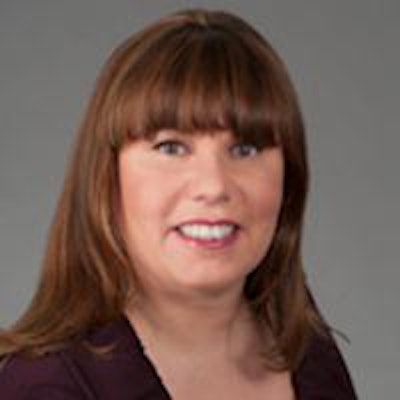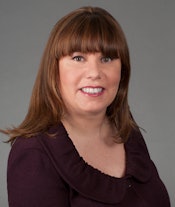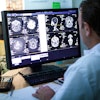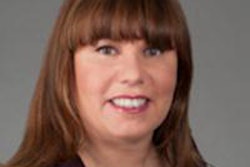
Mornings were rough, but Sylvia was right there with a cup of coffee, just the way I liked it: lots of milk, no sugar. That was pretty special, a mark of importance, because she didn't bring coffee to just anyone -- after all, she was the linchpin of the radiology department.
Why? She ran the file room. She knew every crevice of the place and could spot a misfiled jacket in a heartbeat. She knew every doctor, both radiologist and not, and made sure things were the way we liked them -- maybe sometimes she even gave the tougher cases to someone she didn't like so much.
 Dr. Mary Morrison Saltz.
Dr. Mary Morrison Saltz.
If you needed to make sure someone got a message, Sylvia would make it happen. Running a few minutes late? She had your back. She was the keeper of all information: the old films and the jacket.
Of course the old films were important, and, of course, we need to compare cases image by image, but the jacket itself was very important. Inside, it held the old reports, and outside it held our scribbled notes.
The outside of the jacket was where we wrote notes to our radiologist brethren, so they would know what we know, and have the benefit of knowledge already gained. Cryptic notes such as "Bx canc abnl INR" spoke volumes. They gave history, told us something our colleague had learned, or summarized the key finding. We could read them easily; they were handy, as the jacket was never far from its films; and they told us things not in the formal record, and possibly not in the report.
The peril of handoffs
Communication is key to quality, and handoffs are especially vulnerable to mistakes. Each time a new radiologist looks at a patient, it is essentially a handoff and a time of potential peril. Much attention has recently been paid to the handoff in medicine, because it is clearly identified as a barrier to optimal patient care1 -- a place where a slip may occur, where there's a chasm to cross.
Moving into a digital age, we have lost some of the safeguards we once had. It's not so easy to examine an entire electronic medical record (EMR) to learn a couple of salient points, already discovered by our partner, the last guy who read a case on our patient.
It is not enough to mandate that one should look at the entire record. That's fine to say, but in practice it's impractical to scour the record each time to retrieve the same information.
Not only that, the personal, to-the-point, salient information distilled by a peer is unlikely to be reproduced by natural language processing in the near term.
How can we recreate the handwritten note on the outside of the jacket that conveys the key things we want our partner to know when he or she looks at a case? These notes effectively and easily transmit our knowledge to the next physician, where it might make a difference to what happens to the patient.
Maybe we would like to know that the patient's son is a radiologist or her husband the hospital CEO? That has no place in the formal medical record, nor in a report, but it can be good to know.
Bring back the jacket?
Can we bring back the x-ray jacket? Well, perhaps in a virtual sense: What about a radiology wiki? It could be the place where we can easily enter a few thoughts about a case, passing key information to the next doctor.
A wiki is defined as a website developed collaboratively by a community of users, allowing any user to add and edit content. What if we had a wiki for each patient; a place where we could jot quick virtual notes?
If we're adding a step the patient care process, it must be a true value-added step, not an extra step on which to trip. It should not be a burden, but rather an advantage to us and to the quality of care. The wiki should be easy to use and pop up automatically when we open a case. It should be easily updated with voice recognition software that really works, and it should add otherwise intangible information that we might have jotted down on the x-ray jacket, once upon a time.
Contributing to the wiki must not be just one more thing to do, another form to fill out, another requirement in a long and growing list. It would need to be carefully crafted to allow real usability.
We have lost our file rooms and the folks who ran them. They were the glue that held radiology departments together, but we haven't lost the ability to communicate. The decline of the x-ray jacket clears the way for the rise of other forms of interaction, but we must be careful to remember the importance of the human touch, even if it comes though the digital world.
Staying in touch with our colleagues is critical -- to the quality of care, and to remaining connected with our partners, our teammates, our fellow radiologists. Couldn't a well-designed radiology wiki tied to the PACS help? A virtual note on the jacket?
What do you think?
References
- Farnan JM, Arora VM. A longitudinal approach to handoff training. Virtual Mentor. 2012;14(5):383-388. http://virtualmentor.ama-assn.org/2012/05/medu1-1205.html. Accessed April 26, 2013.
Dr. Mary Morrison Saltz is a board-certified diagnostic radiologist. She is currently CEO of Imagine Image Innovation, a company that uses big data to improve delivery of radiology services.
Most recently, she served as chief medical officer for Hospital Radiology Partners. She has served as radiology chair and service chief at hospitals in Florida, Ohio, and at Emory Johns Creek Hospital in Johns Creek, GA. Dr. Saltz is a member of the American College of Physician Executives, the American College of Radiology, and the Radiological Society of North America, and she sits on the Citizens Advisory Council of the Duke Cancer Institute in Durham, NC.
A hands-on leader, Dr. Saltz's expertise is working hand-in-hand with hospital administration to guide radiology teams to success. Dr. Saltz has led quality assurance programs in Florida and Ohio, and she served as chief quality officer for community practice initiatives at Emory Health Care. She also has more than 20 years of private-practice experience.
She is a graduate of McGill University, with a Bachelor of Science in Human Genetics, and Duke University, where she obtained her Doctor of Medicine. Her postgraduate education included a residency at Boston University where she served as chief resident, and a fellowship in interventional abdominal radiology at Massachusetts General Hospital.
The comments and observations expressed herein do not necessarily reflect the opinions of AuntMinnie.com, nor should they be construed as an endorsement or admonishment of any particular vendor, analyst, industry consultant, or consulting group.



















